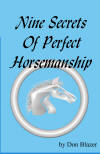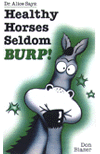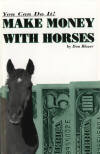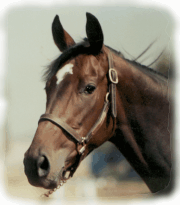
Don Blazer
Archives:
Flying Horses?
Don't eat like a Pig
Parasites
Back Sore?
Goat Hero
Communication
Foals
History of Horses
Jumping Horses
Lameness and Health
Kick the IRS
Meet Don Blazer
Books by Don Blazer
View Our Catalog
Secure Book Order Form
Order using our Secure Order Form

Walter (A Horse, of Course) Spills the Oats
Nine Secrets of Perfect Horsemanship
This is a Secure Web Site
|
With spring busting out all over, foals certainly are.
The other thing Iím not sure of is how much the human population should
increase around the increasing foal population.
Itís not that I donít want people to see the new arrival. Itís just that
most mares and most babies are much happier and healthier if the visitors
are relatively few and far between.
Of course, Iím not worried about the foals born on big ranches or out in
the country. Iím thinking of the city kids; the ones born at the local
boarding stable. Theyíre the ones who suffer too much oooohing, goooooing
and "Isnít he cute."
Itís not that Iím against handling the bouncing bundle. I think every
bouncing bundle should be taught early in life just when itís okay to
bounce and when it isnít.
Iím against too many handlers.
My recommended number is three: mama, the owner and the veterinarian.
Mama will take care of most of the post-foaling work. The owner and the
veterinarian should interfere as little as possible.
A health check for each--the mare, the foal and the owner--and then the
veterinarian can give the recommended vaccinations and leave.
Onlookers, friends, the curious, the nosy and the jealous should not be
tolerated. They should be sent away so the mare and foal can get a little
rest following a big effort.
Iím not even in favor of immediate "imprinting." The latest fad is to
imprint within minutes of the birth, but Iím against it. I believe it is
best to leave mom alone with her foal for several days, then start working
with both.
Foals learn to trust humans and tolerate handling if the handling is
consistent and frequent. If early handling is stressful to mom or baby,
the benefits arenít worth the risks.
Halter breaking--without neck, back or leg breaking should be undertaken
early. If it is started within the first week, and done with a plan and
patience, it can be done very gently.
It is not necessary to show the little one who is boss, it is only
necessary to show the little one.
Hoof care should begin at the age of two weeks. A good farrier can be
relied upon to gently, carefully and very subtly shape and level the tiny
hoofs. If the farrier and owner work together on a two-week schedule, the
little tike should remain free of many leg and joint problems common to
yearlings.
An exercise program which starts within 24 hours of birth, providing
health and weather are good, should be implemented. Little horses were
designed to move with the herd. They need to get out and get going. It
builds their appetite and their bodies.
The excuse, "There isnít any room" or, "Itís too crowded at the stables,"
wonít wash with me. Those are feeble excuses for laziness. Find a way!
Anyone who has a mare in foal and wants all the joys of a new baby can
rise and shine early enough to assure the baby sufficient exercise before
breakfast. And they can turn the tube off and spend their evenings in a
playful romp.
Itíll do every-body a lot of good.
Each month you'll find a new column on our web site. We hope you'll enjoy it, and maybe
e-mail us with questions or suggestions for other
columns. A Horse, Of Course is a weekly column syndicated
by Success Is Easy. If you like the column, call your local newspaper, or local horse
publication and ask them to subscribe by contacting Success Is Easy, 13610 N. Scottsdale Rd., Suite 10-406, Scottsdale, AZ 85254
________________________________
A Horse Of Course |
Horse Books Catalog |
Meet Don Blazer
Ask Don Blazer |
Courses and Clinics |
Horse Training
Horses for Sale |
Who's Walter? |
Horse Links
Home
Info@donblazer.com
Copyright © 2000 by
Don Blazer
Success Is Easy, 13610 N. Scottsdale Rd., Suite 10-406, Scottsdale, AZ 85254
Vanndal Web Designs


